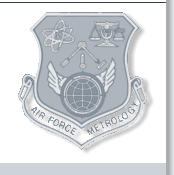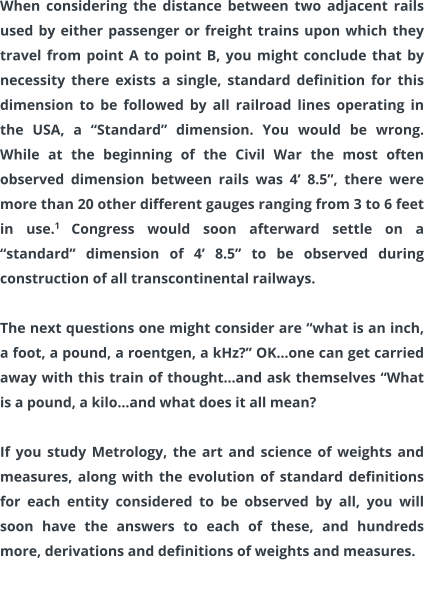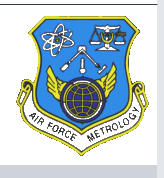



“Illegitimi Non Carborundum”
Last Updated: 11/21/2017 12:21

Metrology,
the
scientific
study
of
measurements
having
origins
in
the
early
19th
century,
formed
from
the
Greek
metron ‘measure’ + -logy.
METROLOGY
But
wait!
Depending
upon
your
fields
of
endeavor…you
certainly
may
be
interested
in
measurement
standards
outside
the
realm
of
just
weights!
How
about
Radio
Frequencies,
Time,
Dimensions,
Pressures,
Stress,
Flatness,
Voltage
and
Currents,
Resistance…just
a
small
sampling
of
items
the
values
of
which
are
all
considered
by
Metrologists
around the world.
The
United
States
established
the
National
Bureau
of
Standards
(today
known
as
NIST)
in
1901
to
address
scientist’s
and
industrialist’s
needs
to
have
an
authoritative
source
of
standards
for
electricity,
length,
mass,
temperature,
light,
and
time,
accompanied
by
a
system
whereby these standards could be transferred to the public.
Uncertainty
plagued
U.
S.
markets
at
the
turn
of
the
20th
century.
There
were
at
least
eight
different
definitions
of
a
gallon,
and
four
different
definitions
for
a
dimensional
“foot”
in
use
at
the
time.
The
NBS
convened
the
first
National
Conference
on
Weights
and
Measures
to
write
model
laws,
distribute
uniform
standards,
and
provide
training
for
inspectors
which
heretofore
had
been
poorly
trained
and
working
with
outmoded
equipment.
(
Continued
)



“Illegitimi Non
Carborundum”
METROLOGY


Metrology,
the
scientific
study
of
measurements
having
origins
in
the
early
19th
century,
formed
from the Greek metron ‘measure’ + -logy.
When
considering
the
distance
between
two
adjacent
rails
used
by
either
passenger
or
freight
trains
upon
which
they
travel
from
point
A
to
point
B,
you
might
conclude
that
by
necessity
there
exists
a
single,
standard
definition
for
this
dimension
to
be
followed
by
all
railroad
lines
operating
in
the
USA,
a
“Standard”
dimension.
You
would
be
wrong.
While
at
the
beginning
of
the
Civil
War
the
most
often
observed
dimension
between
rails
was
4’
8.5”,
there
were
more
than
20
other
different
gauges
ranging
from
3
to
6
feet
in
use.
1
Congress
would
soon
afterward
settle
on
a
“standard”
dimension
of
4’
8.5”
to
be
observed
during
construction of all transcontinental railways.
The
next
questions
one
might
consider
are
“what
is
an
inch,
a
foot?”
OK…one
can
get
carried
away
with
this
train
of
thought…and
ask
themselves
“What
is
a
pound,
a
kilo…and
what does that mean?
If
you
study
Metrology,
the
art
and
science
of
weights
and
measures,
along
with
the
evolution
of
standard
definitions
for
each
entity
considered
to
be
observed
by
all,
you
will
soon
have
the
answers
to
each
of
these,
and
hundreds
more, derivations and definitions of weights and measures.
But
wait!
Depending
upon
your
fields
of
endeavor…you
certainly
may
be
interested
in
measurement
standards
outside
the
realm
of
just
weights!
How
about
Radio
Frequencies,
Time,
Dimensions,
Pressures,
Stress,
Flatness,
Voltage
and
Currents,
Resistance…just
a
small
sampling
of
items
the
values
of
which
are
all
considered
by
Metrologists
around the world.
The
United
States
established
the
National
Bureau
of
Standards
(today
known
as
NIST)
in
1901
to
address
scientist’s
and
industrialist’s
needs
to
have
an
authoritative
source
of
standards
for
electricity,
length,
mass,
temperature,
light,
and
time,
accompanied
by
a
system
whereby
these
standards
could
be
transferred
to
the
public.
Uncertainty
plagued
U.
S.
markets
at
the
turn
of
the
20th
century.
There
were
at
least
eight
different
definitions
of
a
gallon,
and
four
different
definitions
for
a
dimensional
“foot”
in
use
at
the
time.
The
NBS
convened
the
first
National
Conference
on
Weights
and
Measures
to
write
model
laws,
distribute
uniform
standards,
and
provide
training
for
inspectors
which
heretofore
had
been
poorly
trained
and
working
with
outmoded
equipment.
(
Continued
)
1
https://www.truthorfiction.com/railwidth/























